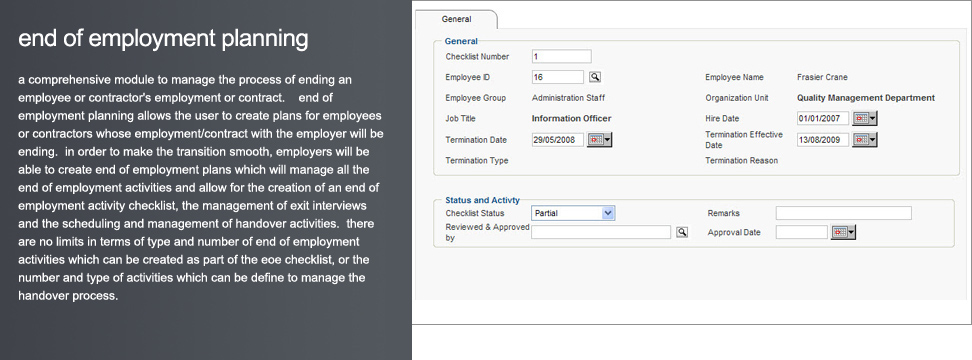Interact HRMS Offboarding Management Module Overview
The Interact HRMS Offboarding Management module provides organizations with a comprehensive solution for managing the end of employment process for employees and contractors. Also known as End of Employment Planning, this module enables HR teams to create detailed offboarding plans to ensure a smooth and structured transition when an employee or contractor’s time with the organization comes to an end. With features for planning end-of-employment activities, managing exit interviews, scheduling handovers, and generating activity checklists, the module simplifies the offboarding process and ensures that all critical tasks are completed.
The offboarding process is crucial for maintaining operational continuity and ensuring that departing employees leave on positive terms. By organizing end-of-employment activities, capturing valuable feedback through exit interviews, and managing handover tasks, the module helps HR teams handle departures professionally and efficiently. Additionally, the Offboarding Management module supports automated notifications and a self-service portal, allowing employees and relevant stakeholders to stay informed about their responsibilities throughout the offboarding process.
Creating End of Employment Plans for Structured Transitions
The Offboarding Management module allows HR teams to create End of Employment Plans for each departing employee or contractor, tailoring the offboarding process to the individual’s role, responsibilities, and reason for departure. These plans outline all required tasks and activities, ensuring that the offboarding process is organized and comprehensive. Whether it’s the end of a long-term employment contract or a short-term project-based role, the module allows HR to set up a plan that covers all necessary steps.
Each End of Employment Plan is customized to meet the needs of the departing employee’s specific role and includes a checklist of activities that need to be completed before their departure. For example, the plan may include tasks such as returning company equipment, completing exit interviews, transferring project responsibilities, and revoking system access. By providing a clear structure for each transition, the module helps organizations manage offboarding consistently and ensures that no critical steps are overlooked.
End of Employment Activity Checklist for Task Management
The module includes an End of Employment Activity Checklist that lists all tasks required to complete the offboarding process. This checklist is a central component of each End of Employment Plan and can be customized to include as many activities as needed. There are no limits on the types and number of activities that can be defined, allowing HR teams to create a thorough checklist tailored to the organization’s offboarding requirements.
Common activities in the checklist may include:
- Collecting company assets (e.g., laptop, mobile phone, ID card)
- Revoking system access and deactivating accounts
- Conducting exit interviews
- Completing final payroll and benefits processing
- Transferring knowledge and handing over project responsibilities
This checklist ensures that all tasks are tracked and completed systematically, minimizing the risk of missed steps. By providing a structured list of activities, the module helps HR teams manage the offboarding process efficiently and ensures that departing employees fulfill all their obligations before their last day.
Exit Interviews with Customizable Questions and Question Groups
The Offboarding Management module includes a feature for conducting Exit Interviews, allowing HR to capture valuable feedback from departing employees. Exit interviews are a key part of the offboarding process, as they provide insights into employee experiences, reasons for leaving, and potential areas for improvement within the organization. The module allows HR teams to build custom exit interview questionnaires with specific questions and question groups tailored to the organization’s needs.
For example, exit interviews may include questions related to job satisfaction, management feedback, work environment, and professional development opportunities. Question groups can be created to focus on different aspects of the employee’s experience, providing a structured and comprehensive view of the reasons behind their departure. Employees can complete their exit interviews through the self-service portal, making it convenient for them to provide feedback even if they are remote or have limited access to in-person meetings.
By gathering detailed feedback through customizable exit interviews, organizations can gain insights into employee retention and make data-driven improvements to their policies, work environment, and management practices.
Scheduling and Managing Handover Activities
To ensure continuity in operations, the Offboarding Management module supports the scheduling and management of Handover Activities. Handover tasks are critical for transferring responsibilities, knowledge, and ongoing project work from the departing employee to their replacement or other team members. The module allows HR to define a list of handover activities and assign them to relevant parties, ensuring that all knowledge and responsibilities are transferred seamlessly.
The module offers flexibility in defining handover activities, allowing HR teams to create as many tasks as needed to cover all aspects of the departing employee’s role. Common handover activities may include transferring client accounts, documenting ongoing projects, and training replacement employees. By structuring and scheduling handover tasks, the module ensures that the organization retains critical knowledge and avoids disruptions in operations caused by employee turnover.
Self-Service Portal for Employee and Stakeholder Engagement
The module includes a self-service portal that enables departing employees and other relevant stakeholders to view and manage their assigned offboarding tasks. Through the self-service portal, employees can access their End of Employment Plan, review the activity checklist, complete exit interview questionnaires, and view the status of their handover activities. This self-service functionality empowers employees to take responsibility for their offboarding tasks and promotes transparency throughout the process.
In addition to employees, other stakeholders involved in the offboarding process—such as team leads, project managers, and HR staff—can view their assigned activities and monitor progress. This engagement with multiple stakeholders ensures that all parties are informed and that each task is completed according to the offboarding plan. The self-service portal also reduces the administrative burden on HR by allowing employees and stakeholders to manage their responsibilities independently.
Automated Email Alerts and Notifications
To keep everyone informed and ensure timely completion of offboarding tasks, the Offboarding Management module includes automated Email Alerts and Notifications. These alerts notify employees and stakeholders of their pending activities, upcoming deadlines, and any changes to the offboarding plan. For example, an email alert may remind an employee to complete their exit interview, or notify a supervisor that they need to approve the return of company assets.
These automated notifications help keep the offboarding process on track, ensuring that tasks are completed before the employee’s last day. By providing timely reminders and updates, the module reduces the likelihood of overlooked tasks and keeps all parties engaged in the process. This proactive approach to communication minimizes delays and supports a smooth transition for departing employees.
Comprehensive Reporting on Offboarding Activities
The module provides robust reporting capabilities that allow HR teams to track and analyze offboarding activities across the organization. HR can generate reports on completed and pending tasks, identify trends in exit interview responses, and monitor the completion status of handover activities. These reports provide valuable insights into the effectiveness of the offboarding process, helping HR teams identify areas for improvement.
For example, reporting on exit interview data can reveal common reasons for employee departures, allowing the organization to address retention issues proactively. Reports on task completion rates can help HR ensure that all offboarding steps are followed consistently, promoting accountability and operational efficiency. By providing detailed insights into offboarding activities, the module enables HR to refine and improve the end-of-employment process continuously.
Data Security and Compliance
The Offboarding Management module is designed to uphold data security and confidentiality throughout the offboarding process. All employee data, including exit interview responses and offboarding activities, is securely stored and accessible only to authorized personnel. The module ensures compliance with data protection regulations, such as GDPR, by restricting access to sensitive information and maintaining a secure environment for employee records.
For example, only HR and authorized stakeholders involved in the offboarding process can access the employee’s offboarding plan and activity checklist, preventing unauthorized access to personal information. By ensuring data security and compliance, the module builds trust with employees and supports the organization’s commitment to protecting their privacy.
Summary: Interact HRMS Offboarding Management
The Interact HRMS Offboarding Management module provides organizations with a structured, comprehensive approach to managing the end of employment process. Key benefits include:
- End of Employment Plans: Create tailored offboarding plans to manage the end of employment for each employee or contractor.
- Activity Checklist: Track all required offboarding tasks with a customizable checklist to ensure a smooth transition.
- Exit Interviews with Custom Questions: Gather valuable feedback from departing employees using customized exit interview questionnaires.
- Scheduling Handover Activities: Ensure seamless knowledge transfer with scheduled handover activities for project and role continuity.
- Self-Service Portal: Empower employees and stakeholders to view and manage their offboarding tasks independently.
- Automated Alerts and Notifications: Keep everyone informed with email reminders for pending activities and upcoming deadlines.
- Comprehensive Reporting: Track and analyze offboarding activities, task completion rates, and exit interview insights.
- Data Security and Compliance: Protect employee information throughout the offboarding process to ensure privacy and regulatory compliance.
By combining these features, the Offboarding Management module enables organizations to handle employee transitions with professionalism, efficiency, and sensitivity. This structured approach to offboarding helps maintain continuity in operations, gather actionable feedback for improving employee retention, and ensure that departing employees leave on positive terms, all while maintaining data security and compliance.


